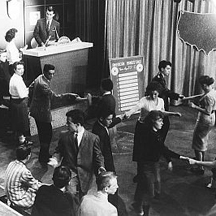AMERICAN BANDSTAND 
“Enough” by Bohemian Vendetta got some local radio play and even had a spot on Dick Clark’s “Rate-a-Record” on American Bandstand. This was, er, enough to get the band some better gigs; they opened for Vanilla Fudge and also another Long Island band the Vagrants. (The Vagrants had a regional hit song with Otis Redding’s “Respect” before Aretha Franklin’s version of “Respect” propelled them from the charts; bandmembers included Leslie West, later a member of the hard rock band Mountain). (April 2011) * * * Rich Rotkin and Arnie Marcus were never involved in any of their recordings, but – together with Phil Stewart – they were the public face of the Rip Chords, since Ernie Bringas was unavailable, and Bruce Johnston and Terry Melcher were much too involved in record production to tour with a band. These Rip Chords had an appearance on Dick Clark’s American Bandstand and joined his Caravan of Stars; they were even in a Hollywood movie, A Swingin’ Summer. (July 2011) * * *
The song was banned in several major radio markets, including New York and Boston (perhaps self-censorship would be a better term, since it was mostly the DJ’s who took it upon themselves not to play the song) due to the fear that its rough sound glorified juvenile delinquency. Even Dick Clark sort of tip-toed around the controversy when the song was introduced on American Bandstand: He never actually mentioned the name of the song.
(February 2013) * * * Ritchie Valens released just two 45’s but still showed incredible versatility. His first, “Come On, Let’s Go” is now regarded as a straight-up rock and roll classic, but it failed to chart. Writing in 1998, Billy Vera recalls “first hearing [“Come On, Let’s Go”] on Alan Freed’s TV Dance Party, a local New York equivalent of Dick Clark’s American Bandstand. It was a record which really grabbed my teenaged ears. I had never heard anything quite like it. It had a much ‘thicker’ sound than anything by Elvis, Chuck Berry, Gene Vincent or even Eddie Cochran. For thickness, the only thing that came close was Bo Diddley.”
* * *
Remarkably, the Big Bopper wrote “Chantilly Lace” while on the way to the Gold Star Studio in Houston; he had originally intended it to be the “B” side for “Purple People Eater Meets Witch Doctor”, but “Chantilly Lace” was on the charts for 22 weeks and topped out at #6. For shows like American Bandstand – where the performers lip-synch to their records – the Big Bopper had a hard time matching his improvised speaking parts and inflections.
(June 2013/1)
* * *
The band changed its name to Danny and the Juniors and. after performing as a last-minute substitute on American Bandstand, had a #1 hit for 7 weeks with “At the Hop” (beginning in January 1958, and breaking the record among vocal groups). In a classic example of so-called “payola”, Artie Singer (who also has a writing credit for “At the Hop”) had to sign over one-half of the publishing credits for the song to Dick Clark (Clark sold the rights to the song prior to the Congressional payola hearings in 1960). (August 2015) |